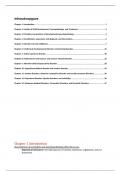Summary
Summary of Disorders of Childhood (2023/2024)
- Course
- Institution
- Book
4th edition Disorders of Childhood ISBN: 9780357796559 Chapter 1. Introduction Chapter 2. Models of Child Development, Psychopathology, and Treatment Chapter 3. Principles and practices of developmental psychopathology Chapter 4. Classification, assessment and diagnosis, and intervention Ch...
[Show more]




